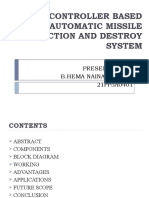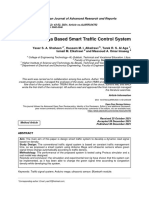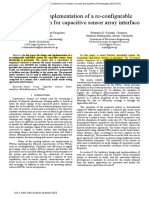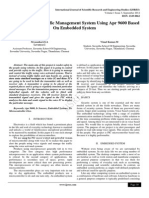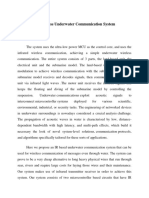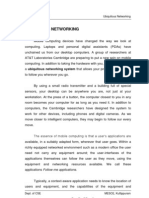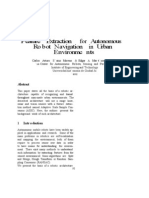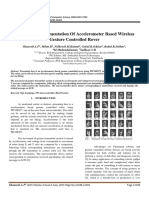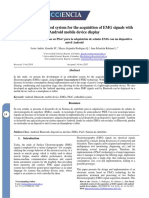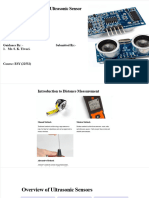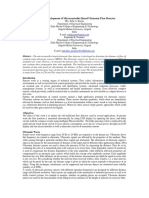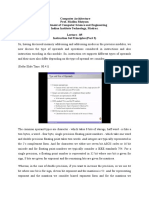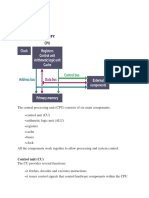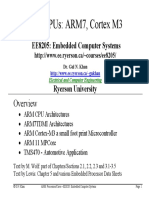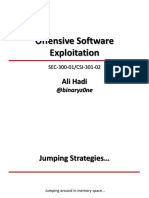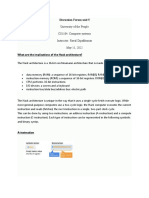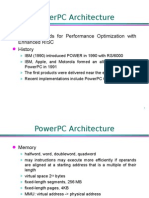Development of An Embedded System For Distance Measuring Using Ultrasonic Sensor
Development of An Embedded System For Distance Measuring Using Ultrasonic Sensor
Uploaded by
nikhithaCopyright:
Available Formats
Development of An Embedded System For Distance Measuring Using Ultrasonic Sensor
Development of An Embedded System For Distance Measuring Using Ultrasonic Sensor
Uploaded by
nikhithaOriginal Description:
Original Title
Copyright
Available Formats
Share this document
Did you find this document useful?
Is this content inappropriate?
Copyright:
Available Formats
Development of An Embedded System For Distance Measuring Using Ultrasonic Sensor
Development of An Embedded System For Distance Measuring Using Ultrasonic Sensor
Uploaded by
nikhithaCopyright:
Available Formats
International Journal of Science and Research (IJSR)
ISSN (Online): 2319-7064
Index Copernicus Value (2013): 6.14 | Impact Factor (2013): 4.438
Development of an Embedded System for Distance
Measuring Using Ultrasonic Sensor
Ms.Varsha Dewangan1, Ms.Barkha Dewangan2, Amit Verma3
1
BE , Electronics & Telecommunication Department, Kruti Institute of Technology and Engineering, Raipur (CG)
missvarshadewangan@gmail.com
2
BE Electronics & Telecommunication Department, Kruti Institute of Technology and Engineering, Raipur (CG)
barkhadewangan26@gmail.com
3
Asst. Professor, Electronics & Telecommunication Department, Kruti Institute of Technology and Engineering, Raipur (CG)
amit8012kruti@gmail.com
Abstract: There are several ways to measure distance without contact. One way is to use ultrasonic waves at 40 kHz for distance
measurement. Ultrasonic transducers measure the amount of time taken for a pulse of sound to travel to a particular surface and return
as the reflected echo. This circuit calculates the distance based on the speed of sound at 25C ambient temperature and shows it on LCD
display. Using it, we can measure distance up to 2.5 meters. In this circuit, a 40 kHz transducer is used for measurement in the air
medium.In this project, we excite the ultrasonic transmitter unit with a 40 kHz pulse burst and expect an echo from the object whose
distance we want to measure. It travels to the object in the air and the echo signal is picked up by another ultrasonic transducer unit
(receiver), also a 40 kHz pre-tuned unit.
Keywords: Ultrasonic sensor, ATMEGA16, LCD module.
1. . Introduction is very commonly used in various devices and circuits. These
modules are preferred over seven segment and other multi
In the existing system, human hand movements are sensed segment LEDs. The reasons being: LCDs are economical;
by the robot through sensors and it follow the same. As the easily programmable; have no limitation of displaying
person moves their hand, the accelerometer also moves special & even custom characters (unlike in seven segments)
accordingly sensor displaces and this sensor senses the animations and so on. A 16x2 LCD means it can display 16
parameter according to the position of hand. characters per line and there are 2 such lines. In this LCD
each character is displayed in 5x7 pixel matrix. This LCD
In this system, a gesture driven robotic vehicle is developed, has two registers, namely, Command and Data. The
in which the vehicle movements and manipulations ie, command register stores the command instructions given to
handling and control is depends on the gesture of the user. In the LCD. A command is an instruction given to LCD to do a
this system, gesture is captured by accelerometer and it is predefined task like initializing it, clearing its screen, setting
processed by software namely, microcontroller software and the cursor position, controlling display etc. The data register
the parameters are sent to microcontroller and encoder stores the data to be displayed on the LCD. The data is the
circuit, It is further transmitted (transmitter section) by ASCII value of the character to be displayed on the LCD.
RF433 MHZ transmitter. In the receiver section, the RF 433 MHZ
receiver holds down the received parameters and process with ATMEGA16 microcontroller: The microcontroller
microcontroller and gives those parameters to the robotic vehicle so
ATMEGA16 has been used to take the controlling action of
that it act accordingly to the gesture. By this system, it is possible
the security system. It is an 8 bit microcontroller with low
to achieve processing of long distance. This system is knowingly
power consumption characteristic. It has advanced RISC
developed to apply in medical field for nursing assistance to
physicians and in surgeries. based architecture. The architecture consists powerful
instruction set which requires only one clock cycle for
execution. This enables the microcontroller to achieve the
2. Block Diagram throughput of 1 MIPS per MHz which results to a very less
power consumption. It is a very high performance
microcontroller. It contains 16KB in self-programmable
flash memory for programming, 512 bytes of EEPROM and
to provide additional security to the software it contains
programming locks. The RISC architecture consists of 131
powerful instructions set in which most of the instruction are
of one clock cycle. The architecture also consists 32 general
purpose registers each of 8 bits. It can give a maximum
throughput of 16 MIPS at the frequency 16 MHZ. It has the
Figure 1: Block diagram of system data retention period of 20-25 years in the room temperature
values.
LCD display:- LCD (Liquid Crystal Display) screen is an
electronic display module and find a wide range of
applications. A 16x2 LCD display is very basic module and
National Conference on Knowledge, Innovation in Technology and Engineering (NCKITE), 10-11 April 2015
Kruti Institute of Technology & Engineering (KITE), Raipur, Chhattisgarh, India
6
Licensed Under Creative Commons Attribution CC BY
International Journal of Science and Research (IJSR)
ISSN (Online): 2319-7064
Index Copernicus Value (2013): 6.14 | Impact Factor (2013): 4.438
Ultrasonic sensor:- Ultrasonic sensors (also known as
transceivers when they both send and receive) work on a
principle similar to radar or sonar which evaluate attributes
of a target by interpreting the echoes from radio or sound
waves respectively. Ultrasonic sensors generate high
frequency sound waves and evaluate the echo which is
received back by the sensor. Sensors calculate the time
interval between sending the signal and receiving the echo to
determine the distance to an object. This technology can be
used for measuring: wind speed and direction (anemometer),
fullness of a tank and speed through air or water. For
measuring speed or direction a device uses multiple detectors
and calculates the speed from the relative distances to Figure 2: Measuring distance using the echolocation concept
particulates in the air water.
3.3 Methodology for distance measurement
Echosignal:- Reflection of sound wave back to its source in The technique of distance measurement using ultrasonic in
sufficient strength and with sufficient time lag to be air include continuous wave & pulse echo technique. In the
separately distinguish is a eco signal pulse echo method, a burst of pulses is sent through the
transmission medium & is reflected by an object kept at
Target:-The object whose distance is to be measured in the special distance. The time taken for the pulse to propagate
atmosphere is termed as target. In addition, objects that from transmitter to receiver is proportional to the distance of
absorb sound or have a soft or irregular surface, such as a object. For contact less measurement of distance, the device
stuffed animal, may not reflect enough sound to be detected has to rely on the target to reflect the pulse back to itself. The
accurately. The sensor will detect the surface of water, target needs to have a proper orientation that is it needs to be
however it is not rated for outdoor use or continual use in a perpendicular to the direction of propagation of the pulses.
wet environment. Condensation on its transducers may affect The amplitude of the received signal gets significantly
performance and lifespan of the device. attenuated and is a function of nature of the medium and the
distance between the transmitter and target. The pulse echo
3. System implementation or time-of-flight method of range measurement is subject to
high levels of signal attenuation when used in an air medium,
3.1 Methodology for ultrasonic sensor thus limiting its distance range.
The ultrasonic sensor for automotive application can detect a The system consists of only one main component, a
target in a short range but the device must be compact and microcontroller unit which acts as the brain of the system.
waterproof .Those requirements limits the application to user Input and output components such as transmitter unit,
friendly system such as parking assist system and rear sonar receiver circuit, temperature control and LCD modules are
system. For pre-crash applications, generally proposed connected to the system brain.The transmitter generates a
sensor like stereo cameras, radar or lidar are able to detect 40Hz signals and begin the transmission time together with
obstacle at long distance, but they are much more expensive the process of sending signals. While the signals begin to
than ultrasonic sensors. This paper proposes a range transmit through ultrasonic transducer, the microcontroller
enhancement method for ultrasonic sensor to make them will capture the starting point of transmission time and hold
usable. Ultrasonic sensors are often called transducers. The it until the receiver gets the echo signal back .The signal will
function of the transducers is to convert electrical energy into contact with any obstacle ahead and will bounce back to the
mechanical energy, which directly corresponds to ultrasonic receiver circuit. When the signal is back ,the receiver must
vibration, and vice versa. The most common way of detect the echo signal, process & send to the microcontroller.
generating and detecting ultrasonic waves utilizes the The microcontroller will stop the transmission time
piezoelectric effect of a certain crystalline material such as immediately and will calculate the range using the
quartz. The system is composed of two sensors, which can transmission time and display the range on LCD modules. If
operate both as transmitter and as receiver. the transmit signal cannot touch any obstacle in front it, or
3.2 Methodology for signal the time is very fast, the system will display error message
on the LCD modules, indicate the range is not suitable for
Transmitter and Receiver Module the system.
The transmitter transmits a high frequency signal. Ultrasonic
sensors emit a sound pulse whose frequency is 40Hz. The 4. Working of microcontroller ATMEGA16
ultrasonic sensor uses a pair of transducers. The sensor emits
a sound pulse and measures the distance of the object The microcontroller ATMEGA16 has been used to take the
depending on the time taken by the echo to return back to the controlling action of the security system. It is an 8 bit
other side.Electrical energy is converted to sound to send the microcontroller with low power consumption characteristic.
pulse, and then the sound received back is converted to It has advanced RISC based architecture. The architecture
digital signal which is displayed in the LCD module. consists powerful instruction set which requires only one
clock cycle for execution. This enables the microcontroller to
achieve the throughput of 1 MIPS per MHz which results to
a very less power consumption. It is a very high performance
National Conference on Knowledge, Innovation in Technology and Engineering (NCKITE), 10-11 April 2015
Kruti Institute of Technology & Engineering (KITE), Raipur, Chhattisgarh, India
7
Licensed Under Creative Commons Attribution CC BY
International Journal of Science and Research (IJSR)
ISSN (Online): 2319-7064
Index Copernicus Value (2013): 6.14 | Impact Factor (2013): 4.438
microcontroller. It contains 16KB in self-programmable 6. Conclusion
flash memory for programming, 512 bytes of EEPROM and
to provide additional security to the software it contains The system is able to detect object within the sensing
programming locks. The RISC architecture consists of 131 range.
powerful instructions set in which most of the instruction are The system can calculate the distance of obstruction with
of one clock cycle. The architecture also consists 32 general sufficient accuracy.
purpose registers each of 8 bits. It can give a maximum This can also communicate with pc through its serial ports.
throughput of 16 MIPS at the frequency 16 MHZ. It has the
This offers a low cost and efficient solution for non-
data retention period of 20-25 years in the room temperature
contact type distance measurement.
values. It provides standard JTAG interface, SPI serial
The microcontroller with LCD makes it user friendly.
interface and ISP interface. It also has programmable serial
USART for serial communication. It has two 8 bit timers Less hardware are used so smaller in size.
with separate prescalers and a 16 bit timer again with Inexpensive components are used so that reduces the cost
separate prescaler, compare and capture mode. It also per unit.
contains real time counters. The microcontroller has four The circuit can easily be implemented on breadboard and
PWM channels each of 8 bits. It has 8 channels of 10 bit tested for its functionality by varying the distance between
analog to digital convertors. It has on chip analog comparator the sensor and the target.
and a watch dog timer with separate prescaler and oscillator. The system can calculate the distance of obstruction with
It has additional features of power on reset, internal and sufficient accuracy.
external interrupt handling and six different sleep modes for This can also communicate with pc through its serial ports.
the effective consumption of power. It has 32 programmable This offers a low cost and efficient solution for non-
input output lines and it is available in 40 pin dual integrated contact type distance measurement.
packages. Its operating voltage is 4.5 to 5.5 volts. The power It is beneficial to use in the places where the accurate
consumption in active mode 1.1mA, in idle mode 0.35 mA readings are not required.
and in power down mode it is < 1A. In the project two
microcontrollers ATMEGA16 are used, one is connected to 7. Future Scope
CPU and another is connected to the alarming system and
GSM modem. The controllers are connected to each other The range can be considerably increased by using high
also. power drive circuit.
Using temperature compensation, it can be used over
wide temperature range.
The resolution of the measurement can be improved by
incorporating phase shift method along with time of
flight method.
Can be used as parking assistance system in vehicles with
high power ultrasonic transmitter.
The 40 kHz signal can be generated using microcontroller
itself which will reduce hardware
We have found that this project is effectively useful in
research and development areas as well as in Army and
Civil area.
Major outcome is that this project can replace too many
costly types of equipments.
Product is also eco friendly because it does not harm any
Figure 3: Pin Diagram of Microcontroller ATMEGA16 Earths environment.
Project is less complicated than other ,so analysis and
5. Results replacement of components is easy.
The working model of the proposed Atmega16 a References
microcontroller-based distance measuring using ultrasonic
sensor was successfully designed and implemented. Fig 6.1 [1] Spasov Peter ,Microcontroller Technology the 68HC11
shows the circuit implemented on a PCB. The performance and 68HC12 Upper Saddle River, Pearson Prentice
of the circuit was analyzed for different conditions. The Hall, Fifth Edition, 2004.
circuit was able to measure distance up to 2m without [2] Sinclair Ian R. and Dunton John,Practical Electronic
interfering in human activity. Circuit was tested for Handbook,6th Edition,2007.
measurement of various distances in different atmospheric [3] Horton Ivor,Beginning C,Wrox Press Ltd,
conditions, accurately.It has a fast response. The ultrasonic Birmingham, U.K, 2nd Edition, 2002.
sensor works fine. It responds to the incoming echo [4] Deshmukh V Ajay, Microcontroller Theory and
accordingly. By using ATMEGA16, we were able to reduce Application.New Delhi, Tata McGraw-Hill Publishing
the cost and increase efficiency Co. Ltd, 2005.
[5] Honeywell Sensing and Control Catalog. (2000) Series
940-942 Ultrasonic Sensors. [Online]. Available:
www.honeywell.ca/sensing/.
National Conference on Knowledge, Innovation in Technology and Engineering (NCKITE), 10-11 April 2015
Kruti Institute of Technology & Engineering (KITE), Raipur, Chhattisgarh, India
8
Licensed Under Creative Commons Attribution CC BY
International Journal of Science and Research (IJSR)
ISSN (Online): 2319-7064
Index Copernicus Value (2013): 6.14 | Impact Factor (2013): 4.438
[6] M. Parrilla, J. J. Anaya, and C. Fritsch, Digital signal
processing techniques for high accuracy ultrasonic
range measurements, IEEE Trans. Instrum. Meas., vol.
40, pp. 759763, Aug. 1991.
[7] D. Marioli, C. Narduzzi, C. Offelli, D. Petri, E.
Sardini, and A. Taroni, Digital time-of-flight
measurement for ultrasonic sensors, IEEE Trans.
Instrum. Meas., vol. 41, pp. 9397, Feb. 1992.
[8] C. Cai and P. L. Regtien, Accurate digital time-of-
flight measurement using self-interference, IEEE
Trans. Instrum. Meas., vol. 42, pp. 990994, Dec. 1993.
[9] F. Gueuning, M. Varlan, C. Eugne, and P. Dupuis,
Accurate distance measurement by an autonomous
ultrasonic system combining time-offlight and phase-
shift methods, in Proc. IMTC, vol. I, pp. 399404 ,
June 46, 1996.
[10] G. Andria, F. Attivissimo, and A. Lanzolla, Digital
measuring techniques for high accuracy ultrasonic
sensor application, in Proc. IMTC, vol. II, pp. 1056
1061 May 18-21, 1998.
[11] Carullo, F. Ferraris, S. Graziani, U. Grimaldi, and M.
Parvis, Ultrasonic distance sensor improvement using
a two-level neural network, IEEE Trans. Instrument.
Measurement, vol. 45, pp. 677682, April 1996.
[12] ENV 13 005, Guide to the expression of uncertainty in
measurement,,May 1999.
[13] U. Grimaldi and M. Parvis, Enhancing ultrasonic
sensor performance by optimization of the driving
signal, Measurement, vol. 14, pp. 219228, 1995.
[14] U. Grimaldi and M. Parvis, Noise-tolerant ultrasonic
distance sensor based on a multiple driving
approach,Measurement, vol. 15, pp. 3341,1995
National Conference on Knowledge, Innovation in Technology and Engineering (NCKITE), 10-11 April 2015
Kruti Institute of Technology & Engineering (KITE), Raipur, Chhattisgarh, India
9
Licensed Under Creative Commons Attribution CC BY
You might also like
- Micro Controller Based Automatic Missile Detection and DestroyDocument17 pagesMicro Controller Based Automatic Missile Detection and DestroyMOHAMMAD ASLAMNo ratings yet
- Dam Monitoring PPT 1Document19 pagesDam Monitoring PPT 1Technos_IncNo ratings yet
- Hazards PDFDocument30 pagesHazards PDFNur Alifah AfandiNo ratings yet
- Arduino Mega Based Smart Traffic ControlDocument10 pagesArduino Mega Based Smart Traffic ControlRamazan Enes BALCINo ratings yet
- Missile Detection and Automatic Destroy SystemDocument5 pagesMissile Detection and Automatic Destroy SystemManoj100% (1)
- The Mpu-6050 Gyroscope Sensor Test by Using Arduino Platform and MatlabDocument4 pagesThe Mpu-6050 Gyroscope Sensor Test by Using Arduino Platform and MatlabPeter0523No ratings yet
- Infrared Object Position Locator: Oladapo, Opeoluwa AyokunleDocument44 pagesInfrared Object Position Locator: Oladapo, Opeoluwa Ayokunleoopeoluwa_1No ratings yet
- Zafeirakis 2018Document4 pagesZafeirakis 2018Tung MaiNo ratings yet
- Project Review On Ultrasonic Distance Measurement: Prakhar Shrivastava, Praveen Kumar, Ankit TiwariDocument3 pagesProject Review On Ultrasonic Distance Measurement: Prakhar Shrivastava, Praveen Kumar, Ankit TiwariSuraj UpadhyayNo ratings yet
- Wireless Sensors Based Data AcquisitionDocument5 pagesWireless Sensors Based Data AcquisitionTv BraviaNo ratings yet
- PBL Project ReportDocument7 pagesPBL Project ReportAhmed HassanNo ratings yet
- Ijece - Sewage Block Identification and Rescue System Using Wireless Sensor - 1Document6 pagesIjece - Sewage Block Identification and Rescue System Using Wireless Sensor - 1iaset123No ratings yet
- Chapter 3Document19 pagesChapter 3MUBARAK RAHAMAN HNo ratings yet
- Jurnal Kimia Radiasi - F1C1 17 009 - Dicky SaputraDocument5 pagesJurnal Kimia Radiasi - F1C1 17 009 - Dicky Saputradicky saputraNo ratings yet
- Wireless Polling Method Using RFDocument101 pagesWireless Polling Method Using RFSravani SravzNo ratings yet
- Distance Measurement Using Ultrasonic Sensor and ArduinoDocument2 pagesDistance Measurement Using Ultrasonic Sensor and ArduinoAwais Zulfiqar75% (4)
- Train Collision Avoiding SystemDocument7 pagesTrain Collision Avoiding SystemIJRASETPublicationsNo ratings yet
- SMARTDUSTBINBASEDONIot-2018Document4 pagesSMARTDUSTBINBASEDONIot-2018mekinjemal999No ratings yet
- Ruben Dupreez B22295Document2 pagesRuben Dupreez B22295Ruben Du PreezNo ratings yet
- Iot Based Flood Monitoring and Controlling SystemDocument9 pagesIot Based Flood Monitoring and Controlling SystemAnisha Arya AryaNo ratings yet
- ART20172334Document4 pagesART20172334alfaristelecomNo ratings yet
- d22 Tkbhaumik VeccDocument2 pagesd22 Tkbhaumik VeccpratikNo ratings yet
- Virtual EyeDocument7 pagesVirtual EyeraviNo ratings yet
- Voice Activated Traffic Management System Using Apr 9600 Based On Embedded SystemDocument7 pagesVoice Activated Traffic Management System Using Apr 9600 Based On Embedded SystemInternational Journal of Scientific Research and Engineering StudiesNo ratings yet
- Microcontroller and Sensors Based Gesture Vocalizer: Ata-Ur-Rehman Salman Afghani Muhammad Akmal Raheel YousafDocument6 pagesMicrocontroller and Sensors Based Gesture Vocalizer: Ata-Ur-Rehman Salman Afghani Muhammad Akmal Raheel YousafBV DarshanNo ratings yet
- Wearable Sensor Network For Lower Limb Angle Estimation in Robotics ApplicationsDocument10 pagesWearable Sensor Network For Lower Limb Angle Estimation in Robotics ApplicationsTELKOMNIKANo ratings yet
- .Follower Robotic Cart Using Ultrasonic SensorDocument4 pages.Follower Robotic Cart Using Ultrasonic SensorArvin LanceNo ratings yet
- PBL Project ProposalDocument4 pagesPBL Project ProposalAhmed HassanNo ratings yet
- 2.IR Wireless Underwater Communication SystemDocument4 pages2.IR Wireless Underwater Communication SystemRamsathaya75% (8)
- Project Review On Ultrasonic Distance Measurement: Prakhar Shrivastava, Praveen Kumar, Ankit TiwariDocument3 pagesProject Review On Ultrasonic Distance Measurement: Prakhar Shrivastava, Praveen Kumar, Ankit TiwarirajatpreetNo ratings yet
- Embed Ed ProjectDocument22 pagesEmbed Ed Projectsunil_kumar0791No ratings yet
- Efficient Location Protocol For Wireless Sensor NetworksDocument11 pagesEfficient Location Protocol For Wireless Sensor NetworksArnav GudduNo ratings yet
- ES Project Report Group 2Document19 pagesES Project Report Group 2mananbhatia243No ratings yet
- .IoT Based Industrial Parameters Monitoring and Alarming System Using Arduino - A Novel ApproachDocument4 pages.IoT Based Industrial Parameters Monitoring and Alarming System Using Arduino - A Novel Approachany tasnimNo ratings yet
- Project Name: Greenhouse Monitoring System Using ArduinoDocument8 pagesProject Name: Greenhouse Monitoring System Using ArduinoyumnaNo ratings yet
- PIC Based Wireless Sensor NetworkDocument5 pagesPIC Based Wireless Sensor NetworkMustafa KhairallahNo ratings yet
- An Asynchronous Interrupt Driven Sampling Technique For A Practical Monitoring System of Power-Line Single-Phase Voltage and Current SignalsDocument11 pagesAn Asynchronous Interrupt Driven Sampling Technique For A Practical Monitoring System of Power-Line Single-Phase Voltage and Current SignalsInternational Journal of Power Electronics and Drive SystemsNo ratings yet
- Smart Sensor Nodes For Airborne Particulate Concentration DetectionDocument10 pagesSmart Sensor Nodes For Airborne Particulate Concentration DetectionSergio MitmaNo ratings yet
- Ubiquitous Networking Full ReportDocument24 pagesUbiquitous Networking Full ReportSurangma ParasharNo ratings yet
- 2021-06-18 Maier Et Al - Single Microcontroller Air Coupled Waveguided Ultrasonic Sonar SubmittedversionDocument4 pages2021-06-18 Maier Et Al - Single Microcontroller Air Coupled Waveguided Ultrasonic Sonar SubmittedversionAHMADNo ratings yet
- PC Based Oscilloscope Using Arduino: AbstractDocument4 pagesPC Based Oscilloscope Using Arduino: AbstractNitin NairNo ratings yet
- COA REPORT OcjiDocument8 pagesCOA REPORT Ocjiffrakesh82No ratings yet
- Stick Blind ManDocument4 pagesStick Blind ManجعفرالشموسيNo ratings yet
- Jurnal Choirul Anam 41417120125Document12 pagesJurnal Choirul Anam 41417120125Choirul AnamNo ratings yet
- Feature Extraction For Autonomous Ro Bot Navigation in Urban Environme NtsDocument8 pagesFeature Extraction For Autonomous Ro Bot Navigation in Urban Environme NtsDouglas IsraelNo ratings yet
- 9 IjecsDocument5 pages9 IjecsRamsathayaNo ratings yet
- PyPhotometry Open Source Python Based Hardware andDocument11 pagesPyPhotometry Open Source Python Based Hardware andতাজ তাজNo ratings yet
- Garbage Monitoring System Using Arduino: October 2017Document5 pagesGarbage Monitoring System Using Arduino: October 2017Mina YakiNo ratings yet
- 100 1464847771 - 02-06-2016 PDFDocument4 pages100 1464847771 - 02-06-2016 PDFEditor IJRITCCNo ratings yet
- Psoc-Based Embedded System For The Acquisition of Emg Signals With Android Mobile Device DisplayDocument6 pagesPsoc-Based Embedded System For The Acquisition of Emg Signals With Android Mobile Device DisplayAlex BogmaNo ratings yet
- Low Cost AvDocument5 pagesLow Cost AvrahulsundaresanNo ratings yet
- Ultrasonic Distance SensorDocument6 pagesUltrasonic Distance SensorJunaid AhmedNo ratings yet
- Distance Measurement Ultrasonic Sensor Using 89s51Document8 pagesDistance Measurement Ultrasonic Sensor Using 89s51Aditi AjankarNo ratings yet
- Design and Development of Microcontroller Based Ultrasonic Flaw DetectorDocument7 pagesDesign and Development of Microcontroller Based Ultrasonic Flaw DetectorBagusElokNo ratings yet
- ENGG5024-1985 Electronic Systems Mini ProjectDocument8 pagesENGG5024-1985 Electronic Systems Mini ProjectAlfred LiNo ratings yet
- Unit 6Document77 pagesUnit 6shindekartik43No ratings yet
- Traffic Data Vertical of Geospatial Data CenterDocument4 pagesTraffic Data Vertical of Geospatial Data CenterVIVA-TECH IJRINo ratings yet
- 6 II February 2018Document6 pages6 II February 2018oyukiisaacNo ratings yet
- 10) Wireless Distance Measurement For Satellites.Document8 pages10) Wireless Distance Measurement For Satellites.kk0511No ratings yet
- Lec 5Document8 pagesLec 5Elisée NdjabuNo ratings yet
- Microprocessors Sjbit Notes PDFDocument185 pagesMicroprocessors Sjbit Notes PDFSankarDChowdaryNo ratings yet
- Q1: Choose The Correct AnswerDocument15 pagesQ1: Choose The Correct AnswerMohammed ShannenNo ratings yet
- ArmDocument8 pagesArmsan4u401No ratings yet
- Basics of Parallel Programming: Unit-1Document79 pagesBasics of Parallel Programming: Unit-1jai shree krishnaNo ratings yet
- 1006 R19 Comp CSC405 QPDocument6 pages1006 R19 Comp CSC405 QPAbhishek BapatNo ratings yet
- GCSE OCR 1.1 Von Neumann ArchitectureDocument62 pagesGCSE OCR 1.1 Von Neumann ArchitectureMichael O’LearyNo ratings yet
- CPU Architecture: Control Unit (CU)Document10 pagesCPU Architecture: Control Unit (CU)i study100% (1)
- MPI Unit 1Document7 pagesMPI Unit 1saichanderNo ratings yet
- 3 System Spec Part eDocument54 pages3 System Spec Part eEsteban RabufettiNo ratings yet
- Arm Cpu CoresDocument64 pagesArm Cpu Coresproc2 unslNo ratings yet
- Lecture - 2 (DIT 1, C&C++)Document2 pagesLecture - 2 (DIT 1, C&C++)shayan zafarNo ratings yet
- Unit 2-Algorithms PDFDocument29 pagesUnit 2-Algorithms PDFAditi ChandraNo ratings yet
- Module 07b JMPDocument21 pagesModule 07b JMPoscar tebarNo ratings yet
- Term Paper - HumeraDocument12 pagesTerm Paper - HumeratamernadeemNo ratings yet
- Mohanlal Sukhadia University, Udaipur: First Year Science Computer ScienceDocument20 pagesMohanlal Sukhadia University, Udaipur: First Year Science Computer ScienceRakesh VaishnavNo ratings yet
- 8086 PipeliningDocument14 pages8086 PipeliningnobodyNo ratings yet
- University of The People CS1104: Computer Systems Instructor: Raval Dipakkumar May 11, 2022Document4 pagesUniversity of The People CS1104: Computer Systems Instructor: Raval Dipakkumar May 11, 2022Qurtiss MayfieldNo ratings yet
- 8086 Supports 6 Types of InstructionsDocument49 pages8086 Supports 6 Types of InstructionsAbdel Hamied EbrahemNo ratings yet
- CMPSB Instruction in Assembly Language of 8086 MicroprocessorDocument6 pagesCMPSB Instruction in Assembly Language of 8086 MicroprocessorJanna Tammar Al-WardNo ratings yet
- MC14442PDocument10 pagesMC14442PRuben AparicioNo ratings yet
- Introduction To MicroprocessorDocument38 pagesIntroduction To Microprocessorcloeyline penalozaNo ratings yet
- 93C66 PDFDocument22 pages93C66 PDFCristian Esteban TamashiroNo ratings yet
- c6 Data SheetDocument118 pagesc6 Data SheetAdmin AkunNo ratings yet
- 8085 SimulatorDocument9 pages8085 SimulatorAshlesha KulkarniNo ratings yet
- Cse2243 Es Lab Manual-2024Document71 pagesCse2243 Es Lab Manual-2024TrisNo ratings yet
- Coma Answers PDFDocument12 pagesComa Answers PDFKrishilNo ratings yet
- Powerpc Architecture: Power Stands For Performance Optimization With Enhanced Risc HistoryDocument15 pagesPowerpc Architecture: Power Stands For Performance Optimization With Enhanced Risc HistorySathis Kumar KathiresanNo ratings yet
- Addressing ModesDocument21 pagesAddressing Modesasmit guptaNo ratings yet
